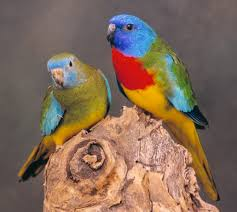Scarlet-Chested Parakeet

Description
The scarlet-chested parrot (Neophema splendida), known alternately as scarlet-breasted parrot, orange-throated parrot or splendid parrot, is a parrot endemic to central South Australia and inland southern Western Australia. The species is sexually dimorphic; the male has a bright blue face and scarlet chest and yellow underparts, amid overall green plumage, while the female is similar but lacks the red chest. These nomadic parakeets move readily from the Great Victoria Desert region into neighbouring areas. These interruptions are triggered by a search for more favourable conditions. They can survive quite well without access to drinking water, however, as succulent plants help meet much of their fluid requirement. They feed mainly on grass seeds and are most commonly sighted in spinifex.
Measuring 19–21 cm (8 in) in length, this small vibrant and brightly coloured parrot is sexually dimorphic. The male has a scarlet chest, a cobalt blue face, and bright green upperparts. The lower breast and underparts are yellow, and the wing coverts are pale blue. The tail is green, the eyes are brown and the bill is blackish, and legs are brown-grey. The female likewise has a blue face, although the coloration is less extensive, green upperparts and green breast, with yellow underparts. Immature birds are duller versions of their respective adult forms. Males begin to get red plumage on their chest from around two or three months of age, though do not complete their red chest until fifteen to eighteen months old.
The female resembles the female turquoise parrot (N. pulchella) of eastern Australia, but can be distinguished by the blue lores and paler blue wing patch.
The call is a soft twittering, quieter than other members of the genus Neophema.
Scientific Name
Neophema Splendida
Country Of Origin
Australia
Size
Life Expectancy
Noise Level
Low
Talk / Trick Ability
Along with the turquoisine parakeet, the scarlet-chested parakeets is one of the most temperamental and quirky Australian parakeet. The scarlet-chested parakeet may need additional attention because they can be fragile birds. They need warmer housing to ensure the longevity. Being busy bodies, these pet birds are active around their aviary – feeding, flying and running around.
Characteristics
Scarlet-chested parakeets enjoy fresh greens along with fruits, eggfood, multi-grain bread and other fresh vegetables. Before breeding this bird, especially for mutations, the decision should be well thought out because scarlet-chested parakeets are fragile, with their mutations being even frailer. Scarlet-chested males have a bright red chest while the female lacks the red coloring on the chest. There are many mutations of these parakeets, including cinnamon, par-blue, white-chested blue, seagreen, lutino, silver, full-red fronted and pied.
Expert Advice
“Their colors are the main attraction. Scarlet-chested parakeets are very delicate when young, especially when molting. They have a very low tolerance to cold drafts but can take cold down to 40-degrees Faraneheit if they become accustomed to it.”
Melinda Schmitz, owner of Anza’s Australian Beauties aviaries